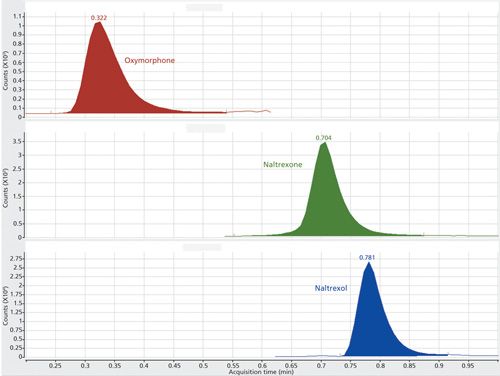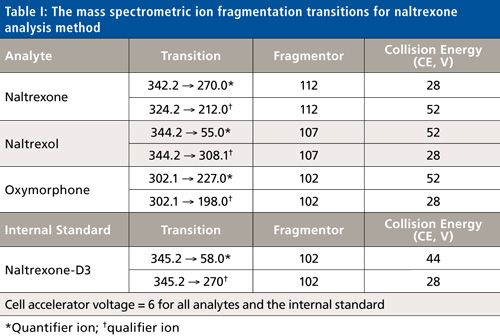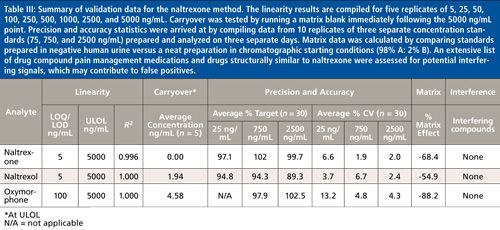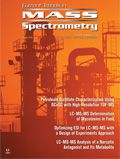A Rapid, Selective, and Sensitive Method for the Analysis of Naltrexone and 6β-Naltrexol in Urine
Special Issues
An LC–MS-MS method is presented that can assist with monitoring substance abuse patients who are prescribed naltrexone, a narcotic antagonist.
Naltrexone (Depade, Re Via, and Trexan) is a potent narcotic antagonist structurally similar to oxymorphone and naloxone. It blocks the subjective effects of heroin and other opiates and is primarily used in the management of opioid dependence and alcohol dependence. While conjugated 6β-naltrexol is the major urinary metabolite in man, conjugated naltrexone and free 6β-naltrexol are also major urinary species. To assist with monitoring substance abuse patients who are prescribed naltrexone, a rapid, selective, and sensitive liquid chromatography–tandem mass spectrometry (LC–MS-MS) method was developed to analyze for both naltrexone and 6β-naltrexol post-enzymatic hydrolysis. The validation of this method and some representative patient data are discussed in this article.
Naltrexone is a pure narcotic antagonist structurally similar to oxymorphone and naloxone. It blocks the subjective effects of heroin and other opiates and is primarily used in the management of opioid and alcohol dependence (1). The drug is supplied as 25-mg or 50-mg tablets (under the brands Depade, ReVia, and Trexan) (2) and as an extended-release injectable formulation (Vivitrol) (3), which is administered monthly as an intramuscular injection (1). Naltrexone undergoes extensive first-pass metabolism, and up to 70% of a dose can be recovered in urine within 24 h (1,4). Conjugated 6β-naltrexol (naltrexol) is the major urinary metabolite in humans, and conjugated naltrexone and free naltrexol are other known major urinary species (5). Naltrexol has significant pharmacological activity with a half-life that is greater than three times its parent, naltrexone (6).
Many of the published analytical methods used to detect naltrexone and its metabolites were reported in plasma, which is a more complex matrix and usually requires more sample processing and cleanup when compared to urine (5,7–9). In a high-throughput laboratory environment, the emphasis is on developing methods that are not only rapid but also sensitive and selective. In view of that, this work demonstrates a method that requires dilution with internal standard, hydrolysis, and centrifugation. The subsequent analysis of naltrexone demonstrates toxicologically acceptable limits of quantitation (LOQs) and limits of detection (LODs) and robust instrument performance that minimizes instrument utilization time when analyzing naltrexone in urine.
The resulting method reported herein has a 1.7-min run time and a 2.7-min cycle time using a liquid chromatography–tandem mass spectrometry (LC–MS-MS) system. Limits of quantitation for both naltrexone and 6β-naltrexol were determined to be 5 ng/mL. The development and validation of this method are discussed in further detail in this article.
Methods and Materials
Chemicals
Reference standards for naltrexone, naltrexone-D3, 6β-naltrexol, oxymorphone glucuronide, and oxymorphone were purchased from Cerilliant. All solvents, including methanol (Optima grade), acetonitrile (Optima grade), isopropanol (Optima grade), 0.2 M phosphate buffer (pH 7.5), and formic acid (88%) were purchased from VWR. Drug free urine was obtained from Utak Laboratories. IMCSzyme, a recombinant β-glucuronidase, was purchased from IMCS.
Instrumentation
The analytical method was developed using an Agilent 6460 LC–MS-MS system. After testing several ultrahigh-pressure liquid chromatography (UHPLC) columns, a 50 mm x 4.6 mm, 100-Å, 2.6-µm dp Phenomenex Phenyl Hexyl column coupled with a Phenomenex guard cartridge (Phenyl) was used to validate this method. The column temperature was maintained at 50 °C during analysis.
Patient Sample Preparation
Patient urine specimens (50 µL) were diluted 10x with a mastermix consisting of 1.6 µg/mL of naltrexone-D3 and 2000 units of a recombinant β-glucuronidase from IMCS (IMCSzyme) in 0.02 M phosphate buffer, pH 7.5. Samples were incubated in an oven for 60 min at 60 °C for hydrolysis. Earlier studies using oxymorphone glucuronide (naltrexone glucuronide is not commercially available) demonstrated the time course of hydrolysis for these analytes required >60 min for complete hydrolysis. It was determined that a hydrolysis time of 60 min provided stable and consistent results with a control. A correction factor of 1.14-adjusting for approximately 88% hydrolysis efficiency-was applied to results to mimic complete hydrolysis. Samples were removed from the oven and centrifuged before analysis by LC–MS-MS.
Standard Preparation
Reference standards were diluted to appropriate calibrator level concentrations (5, 10, 50, 250, 1000, and 5000 ng/mL) in normal human urine and were then diluted an additional 10x as detailed above. The standards were meant to mimic the already 10x diluted patient samples. An oxymorphone glucuronide hydrolysis control was used to ensure the enzyme–mastermix was acceptable for every batch in addition to a positive and negative control.
Method Validation
This method was validated for naltrexone and naltrexol as per an internal standard operating procedure (SOP) based upon College of American Pathologist requirements (10) and applied to authentic positive urine samples to evaluate efficacy for adherence drug testing. For a standard at any concentration level to be considered passing, during the validation of this method, quantitation must be within ±25% of the expected value and ion ratios and chromatographic requirements must pass for all analytes assessed. Quantitation values are based on a passing calibration curve (no points excluded and R2 value greater than or equal to 0.99), which must be freshly prepared and analyzed on the same day that the particular validation study was conducted. Furthermore, the coefficient of variation (CV) between sets of replicates must be ≤15%. Experiments performed during the method validation process are explained in greater detail below.
Limits or Sensitivity
The lower and upper concentration limits at which the method could accurately identify and quantify analytes were evaluated. To establish reliable LODs and LOQs, four out of five replicates must pass for the necessary criteria when compared to a passing calibration curve (detailed above). The LOD and LOQ both require the analyte signal to demonstrate reproducible ion ratio stability, while the LOQ requires the analyte signal to demonstrate reproducible quantitation.
Linearity
Linearity is the reproducible regression or fit of the calibration curve compared to expected concentration values. Four of the five replicates of each linearity point-usually comprising the calibrators and a minimum of five additional points within the analytical range-must pass all validation criteria.
Carryover
Carryover is the highest quantitative level of analytes present that do not produce a concentration level above the lower limit of quantitation in a subsequent blank injection. Carryover is investigated to ensure false positives are alleviated in a production environment. This experiment requires four of five blank injections following each of the five replicates at the potential carryover limit concentration to quantitate lower than the established LOQ.
Precision and Accuracy
The precision and accuracy test measures the capability of the method to yield reproducibly accurate results over a period of multiple days at concentrations spanning the concentration range of interest. A total of 10 replicates of three concentrations (omitting calibration points) within the analytical range of interest are chosen and run on three separate days. Out of these 10 injections, nine must pass within 25% of the target concentration.
Interference–Selectivity
The ability of the method to be unaffected by the presence of other medications or compounds is the interference–selectivity. Interference would be considered confirmed if a false signal met or exceeded LOQ requirements (that is, was higher than the LOQ and had a passing ion ratio) in greater than one of the five replicates that must be run for each individual test.
Matrix Effects
Matrix effects are the suppression or enhancement of analyte signals of interest because of the presence of matrix-in this case urine. The effect of matrix on the method was evaluated by running the quality control (QC) concentration of 750 ng/mL both in matrix and in the LC starting conditions (98% 5 mM ammonium formate in 10% methanol: 2% methanol).
Patient Evaluation and Comparison
This test is used to confirm whether a new method accurately quantitates actual patient samples when compared to the currently in-use and accepted method for these analytes (10). The previously validated method used a Waters Acquity TQD system and had been in regular daily use for more than a year. To make this comparison, all recent patient positive urine samples for the analytes in this method were prepared using the new procedure and compared to the previous method.
Results and Discussion
Daily calibration curves (5, 10, 50, 250, 1000, and 5000 ng/mL) routinely demonstrated 100 ± 25% accuracy for each point and excellent goodness of fit (R2 > 0.99). Calibration curves for oxymorphone only included 250, 1000, and 5000 ng/mL as the hydrolysis control was set to liberate 1577.8 ng/mL. Consistent peak shapes and ion ratios were achieved for naltrexone, naltrexol, and oxymorphone. A typical chromatogram is shown in Figure 1 for the 100 ng/mL calibrator demonstrating the separation achieved for this 1.7-min method; note that naltrexol, the latest eluted, is retained well before 1 min of the gradient. The longer run time (1.7 min) and cycle time (2.7 min) are necessary for column equilibration and needle washing–carryover reduction, respectively. Details about the LC gradient and MS ion fragmentation transitions used are described in Tables I and II, respectively. Compiled results for all conducted method validation experiments are shown in Table III.

Figure 1: Example chromatogram of a 100-ng/mL sample injection (internal standard excluded).


The LOD and LOQ for naltrexone and naltrexol were determined to be 5 ng/mL and 100 ng/mL for oxymorphone. No appreciable carryover was observed following the highest curve point of 5000 ng/mL (see Table III). The precision and accuracy was evaluated by assessing 10 replicates of standards at 75, 750, and 2500 ng/mL on three separate days-usually there is at least one skipped day between precision and accuracy experiments. The precision and accuracy results shown in Table III demonstrate the robustness of this method for all three analytes at the three concentration levels tested.
All analytes experienced suppressed signal response when dissolved in normal human urine compared to a neat preparation in mobile phase initial conditions (98% 5 mM ammonium formate in 10% methanol: 2% methanol). Different methods can be used to calculate the effect of the matrix on the signal response. To calculate the percentages presented in Table III the relationship between the absolute responses is used since it is believed to present a more thorough picture than comparison of relative responses or calculated concentrations.
The interference study was conducted and there were no identified interferences for any of the analytes in this method. Interference analytes included structurally similar compounds such as naloxone, 6α-naloxol, codeine, oxycodone, noroxycodone, hydromorphone, hydrocodone, and norhydrocodone as well as panels of common drugs of abuse such as opiates, opioids, and benzodiazepines.
Analysis of Patient Samples
In addition to the validation, the patient samples tested showed 100% qualitative correlation between the original method and the newly validated method. Results from patient samples submitted who tested positive using this method and had known prescriptions for naltrexone (tablets or injectables) are listed in Table IV. Of the 7158 patient samples analyzed over a one-month period in a production setting using this method, 125 had known prescriptions and 90 tested positive while also passing all the specimen validity criteria (11,12). The summary of this sample set (positive patients with a known prescription) is presented in Table IV.

Analysis of naltrexone dosages show a range of 15 ng/mL to 42,017 ng/mL with a mean of 4506 ng/mL for daily tablets (50 mg taken between once and thrice daily) and a narrower range of 18 ng/mL to 18,389 ng/mL for the injectable Vivitrol formulation with a mean of 1381 ng/mL. It is difficult to assess a mean for these data because of the large discrepancies between measured concentration values for patients with both dosage forms. The median is a more meaningful measure for these data and is higher for patients taking the injectable form of naltrexone when compared to those taking the daily tablets.
Conclusion
This work demonstrates that the analysis of naltrexone and its major metabolite, 6β-naltrexol, can be adequately assessed in a rapid LC–MS-MS quantitative method following hydrolysis. Key features of the method include hydrolysis using a recombinant enzyme and a cycle time of 2.7 min while achieving the high level of selectivity and specificity required for naltrexone and naltrexol. The results from this method compare well with the same samples run with an LC–MS-MS method on a different system. This newly developed method uses different transitions and a comparable column and reduces the cycle time by approximately 1 min.
References
- R.C. Baselt, Disposition of Toxic Drugs and Chemicals in Man, 10th Edition (Biomedical Publications, Seal Beach, California, 2014), pp. 1419–1420.
- Depade (package insert), Hazelwood, Missouri, Mallinckrodt Pharmaceuticals Inc. (2014).
- Vivitrol (package insert), Waltham, Massachusetts, Alkermes Inc. (2010).
- K. Verebay, M.J. Kogan, A. de Pace, and S.J. Mule, J. Chrom.118, 331–335 (1976).
- W. Huang, D.E. Moody, R.L. Foltz, and S.L. Walsh, J. Anal. Tox.21, 252–257 (1997).
- E.J. Cone, C.W. Gorodetzky, and S.Y. Yeh, Drug Metab. Disp. 2, 506–512 (1974).
- M.H. Slawson et al., J. Anal. Tox.31, 453–461 (2007).
- C. Clavijo et al., J. Chrom. B.874, 33–41 (2008).
- A.F. Davidson, T.A. Emm, and H.J. Pieniaszek, J. Pharmaceut. Biomed. Anal.14, 1717–1725 (1996).
- J.R. Enders and G.L.McIntire, J. Anal. Toxicol. 39(8), 662–667 (2015).
- D.M. Bush, Forensic Sci. Int.174(2–3), 111–119 (2008).
- Substance Abuse and Mental Health Services Administration Department of Health and Human Services, “Mandatory Guidelines for Federal Workplace Drug Testing Programs,” Federal Register 69, 19643–19673 (2004).
Oneka T. Cummings, Erin C. Strickland, and Gregory L. McIntire are with Ameritox, Ltd., in Greensboro, North Carolina. Direct correspondence to: Erin.Strickland@ameritox.com

New Method Explored for the Detection of CECs in Crops Irrigated with Contaminated Water
April 30th 2025This new study presents a validated QuEChERS–LC-MS/MS method for detecting eight persistent, mobile, and toxic substances in escarole, tomatoes, and tomato leaves irrigated with contaminated water.

.png&w=3840&q=75)

.png&w=3840&q=75)



.png&w=3840&q=75)



.png&w=3840&q=75)







